Apple Vision Pro: everything you need to know about the mixed reality headset
The long-awaited Apple VR headset is here and it's actually MR, or mixed reality
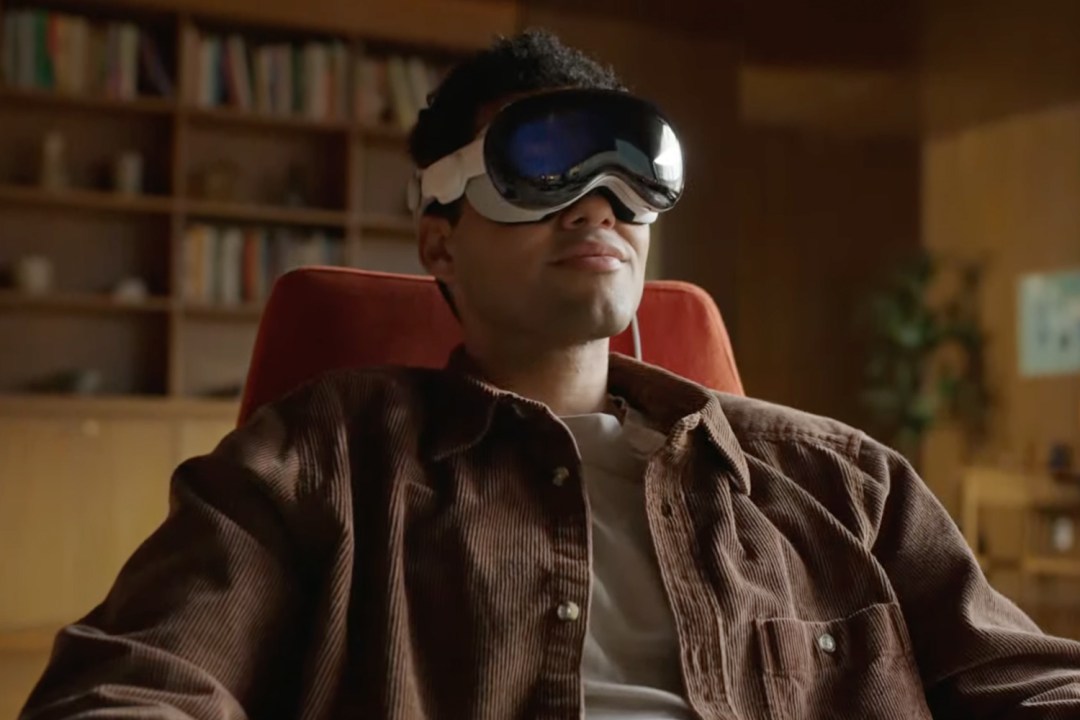
Apple doesn’t launch entirely new products very often, so the Apple Vision Pro mixed reality headset is huge news and one of the biggest gadget releases of the last couple of years. Rumors mean that we have been expecting an Apple VR headset to be announced for some time, but Vision Pro’s reality is a bit more advanced than that.
Rather than bringing you pure virtual reality or VR, the Vision Pro is a mixed reality (MR) headset with passthrough vision of the world around you. It superimposes a full app-based operating system on top, called visionOS. It takes many cues from iOS and iPadOS.
As more people use the headset in the US (as that’s where it’s exclusively available at present), I’m finding out more information all the time about Vision Pro. So I’m bringing you everything I know so far right here on this page.
We’ve also bought an Apple Vision Pro, here’s what we think after testing it out.
Apple reckons that Vision Pro is the “most advanced consumer electronics device ever”. And it’s probably not wrong. But is it actually for consumers? The jury is still out on that one and certainly social channels have shown people returning their headsets, something picked up on by various outlets.
But that doesn’t mean that the product is a failure – analysts suggest that pre-order sales were somewhere between 160,000-200,000.
It’s certainly Apple’s most revolutionary product since the iPhone – yes, even more so than the Apple Watch.
It seems that the product has been in development for some time (various patents have surfaced including this one from 2018 to adjust the display) and it’s very likely that Apple knows how the product will develop over time – which will be rather exciting to see.
Vision Pro price and availability
Vision Pro is a hugely expensive device, costing $3499 (around £2757). And there’s no getting away from the fact the price is much higher than rumoured. As we mentioned above, it’s a US-only device at present and Apple is quite clear on its guidance here: “Apple Vision Pro is only available for sale in the US and is designed for customers in the U.S. to use at home, at work, and while traveling. We look forward to bringing Apple Vision Pro to more countries later this year.”
Expect those countries to include the places Apple traditionally launches products first. For iPhone 15 the first wave included Australia, Canada, China, France, Germany, India, Japan, Mexico, the UAE and the UK (in addition to the US).
Mirroring the iPhone’s 2007 debut, I think the UK will get it later in the year alongside Canada – this could be as early as mid-year. Other countries including France, Germany, Australia, China, Hong Kong, Japan and Korea will get it closer to 2025. Yep, that’s a long wait by which point Apple may be close to announcing a more accessible (cheaper?) successor.
As well as the headset itself, which has 256GB of onboard storage, early adopters get both a Solo Knit Band and Dual Loop band, a light seal insert (plus two light seal cushions), a cover, polishing cloth, power adapter and USB-C charging cable in the box. Zeiss prescription reading inserts are an additional $99, while prescription lenses are $149.
There is a hard case for the Vision Pro, but it’s available separately and costs a whopping $199. You can also get additional batteries, again for $199 (this seems particularly crazy). And Apple is also stocking accessories, such as this $50 Belkin battery holder so you can have it on your belt if you don’t want it in your pocket.
There’s also a ‘Developer Strap’ accessory for connecting the headset to a Mac with USB-C. This one is perhaps the most outrageously-priced at $300. It’s also how Apple will diagnose any problems with Vision Pro in an Apple Store.
Apple Vision Pro at a glance
- You control the headset using gestures – there are no controllers.
- The Vision Pro is not wireless – it has a cable and is made from aluminium, glass and carbon fibre. There is a pocketable battery pack to cut down on weight. The battery life will last around two hours.
- The top has a digital crown-type control just like on the Apple Watch which you can use to focus in on things.
- There’s an Apple Watch-style home screen with apps.
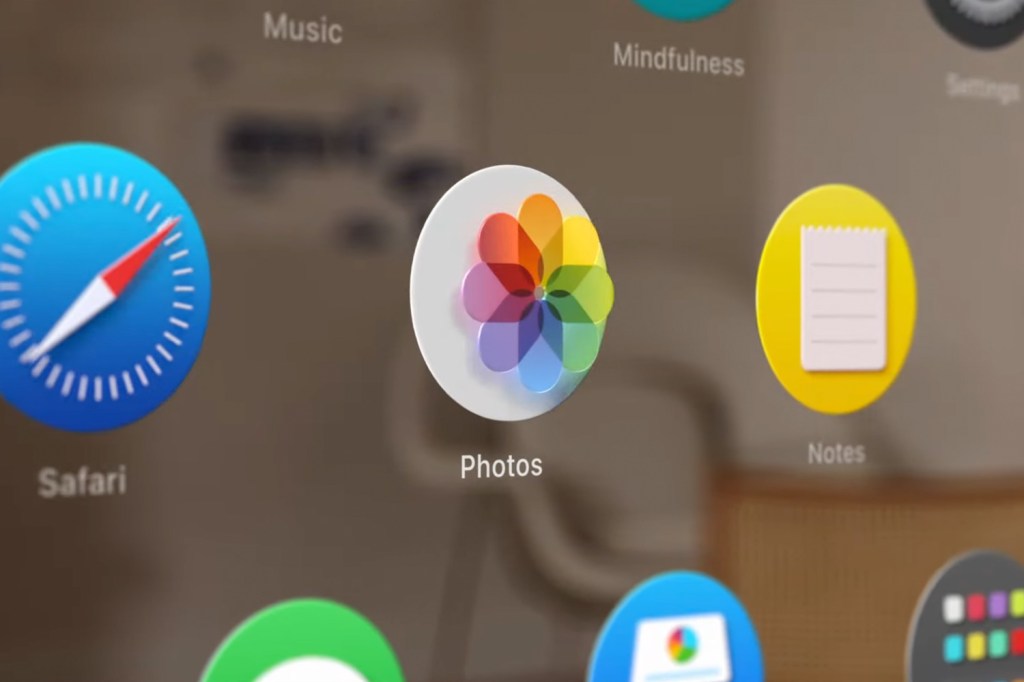
- You can scale apps up or down, and place them anywhere in your space.
- Apps respond to where you move your eyes.
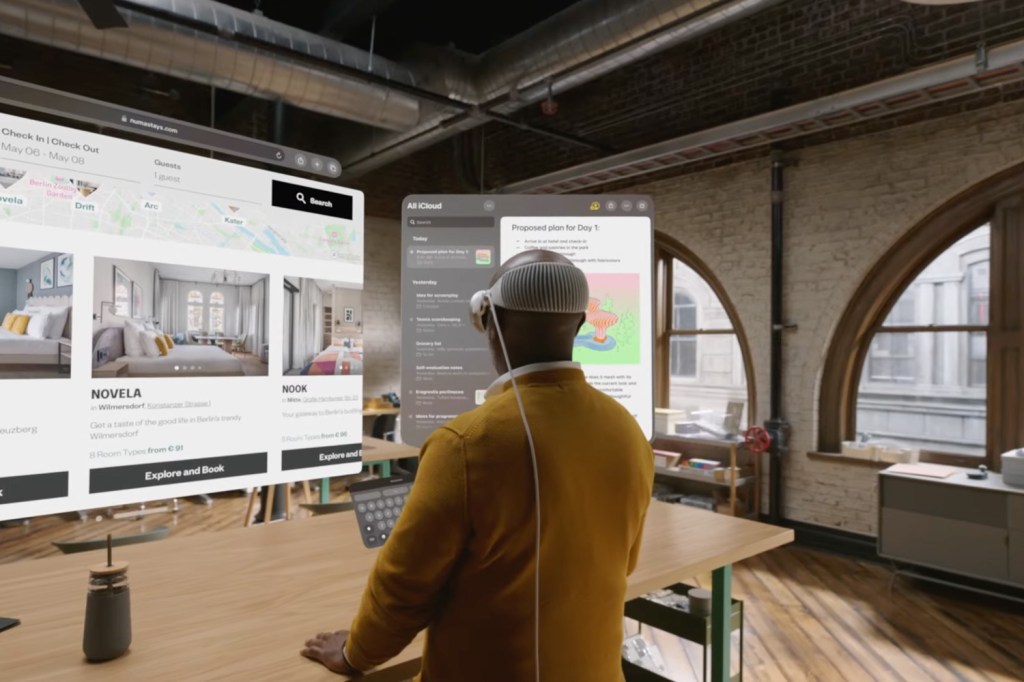
- Siri enables you to dictate into text boxes or control anything with your voice.
- EyeSight is a feature that means Vision Pro displays your eyes when other people are nearby. People nearby will appear in your virtual view as well.
- It can work alongside your Mac as a way to use your desktop (essentially acting as another display). It will also work with accessories such as the Magic Trackpad.
- Apple’s own apps have been redesigned for the headset. You can expand tabs in Safari or send 3D objects in messages. The 3D cameras enable you to capture the content. There are well over 200 native Vision Pro apps available already.
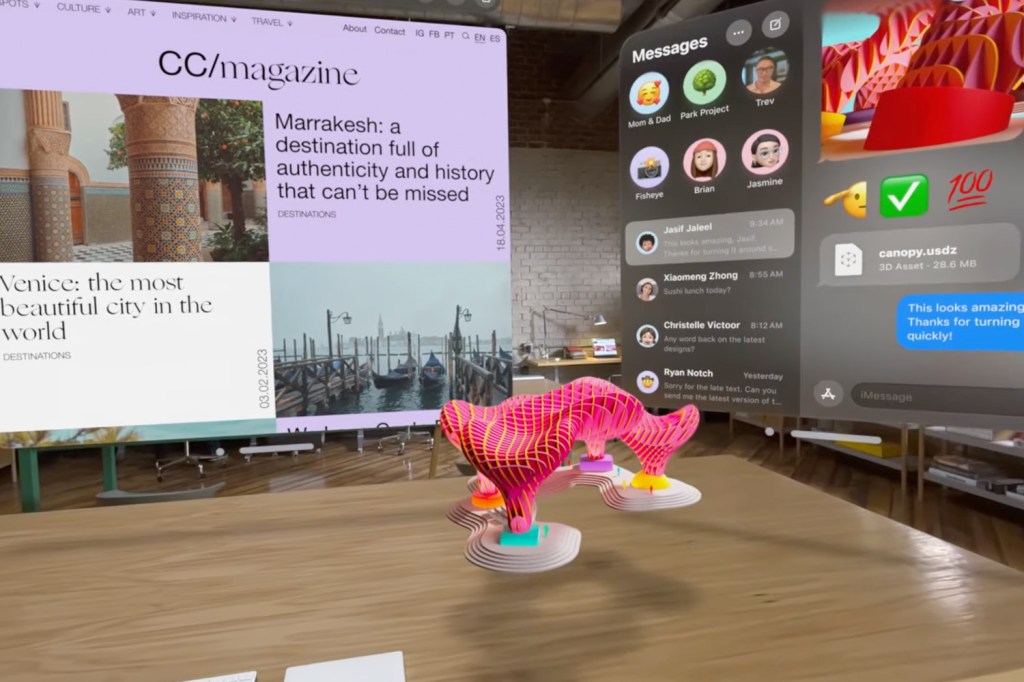
- FaceTime now places people in the room around you. You can also share content through SharePlay and watch things together with others.
- iPad and iPhone apps will be available in the Vision Pro app store and there is support for Unity. There will be over 100 Apple Arcade games available for it on day one.
- Spatial audio is supported.
- There are two Apple Silicon chips on board Vision Pro.
- Optic ID uses your iris to identify you. Like Face ID, this information doesn’t leave your device.
So what is the Apple Vision Pro capable of?
The Apple Vision Pro is a mixed reality (MR) headset – Tim Cook suggested during the announcement that the Vision Pro represented the introduction to “spatial computing” as opposed to the iPhone changing mobile computing. The firm says Vision Pro “seamlessly blends digital content with the physical world, while allowing users to stay present and connected to others.”
Instead of just being a virtual world that you see, it overlays information and images on the real world. That puts it somewhere in the sphere of Microsoft Hololens (not moving onto a third version, it seems) and Google Glass. That would also make sense given Apple’s work on ARKit for the iPad and iPhone.
Developers have able to apply for an Apple Vision Pro dev kit on loan for months now, but security around them was tight. MacRumors suggests the Vision Pro headset will be AirTag-tracked and will come in a lockable Pelican case that must be kept securely.
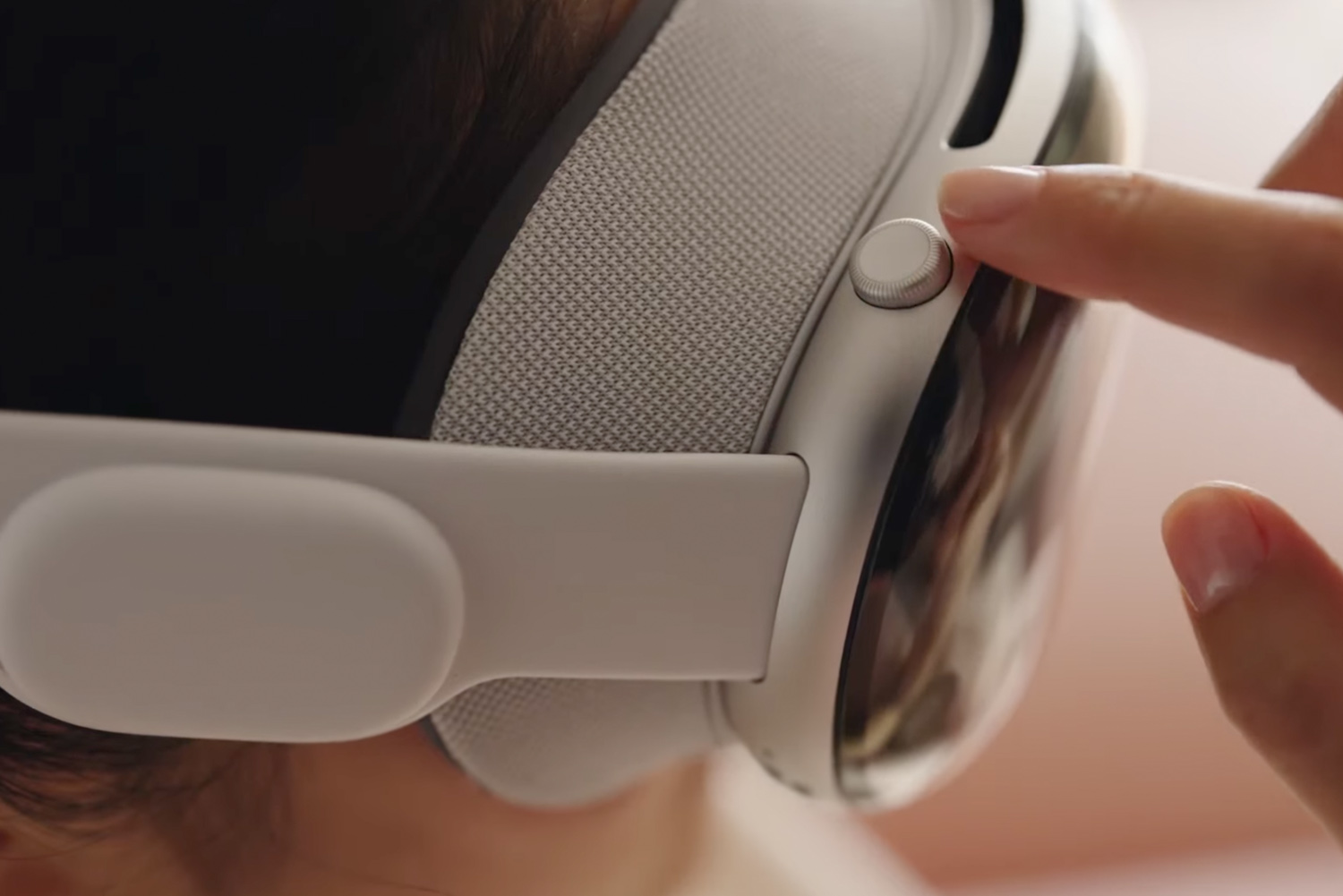
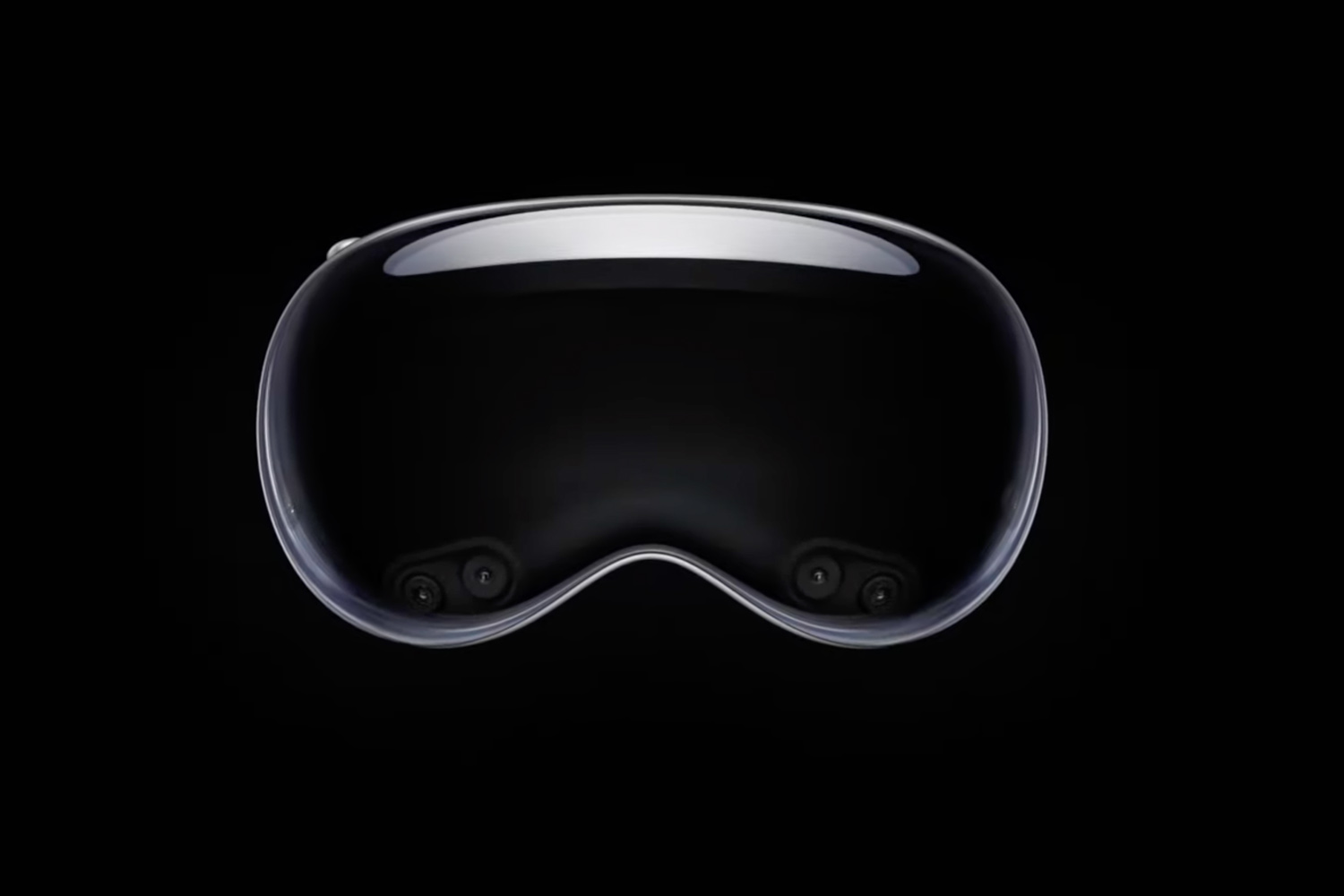
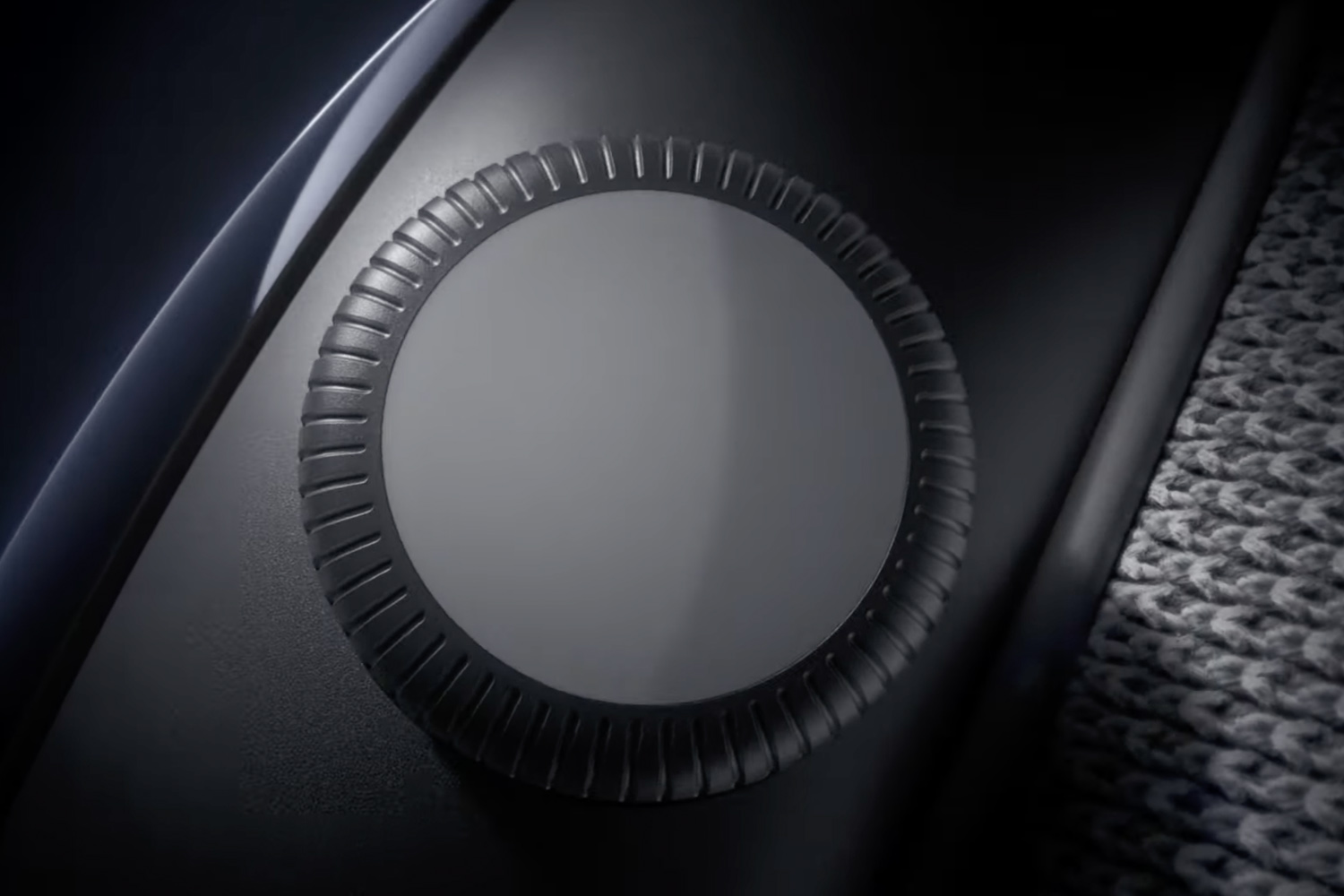
Apple Vision Pro design
Vision Pro is made from aluminium, glass and carbon fibre. The front of the headset is polished glass, while there is a lightweight aluminium frame that curves towards your face and customised fabric mesh pad (called a Light Seal) against the head. It’s been designed so heat is drawn away from the headset itself.
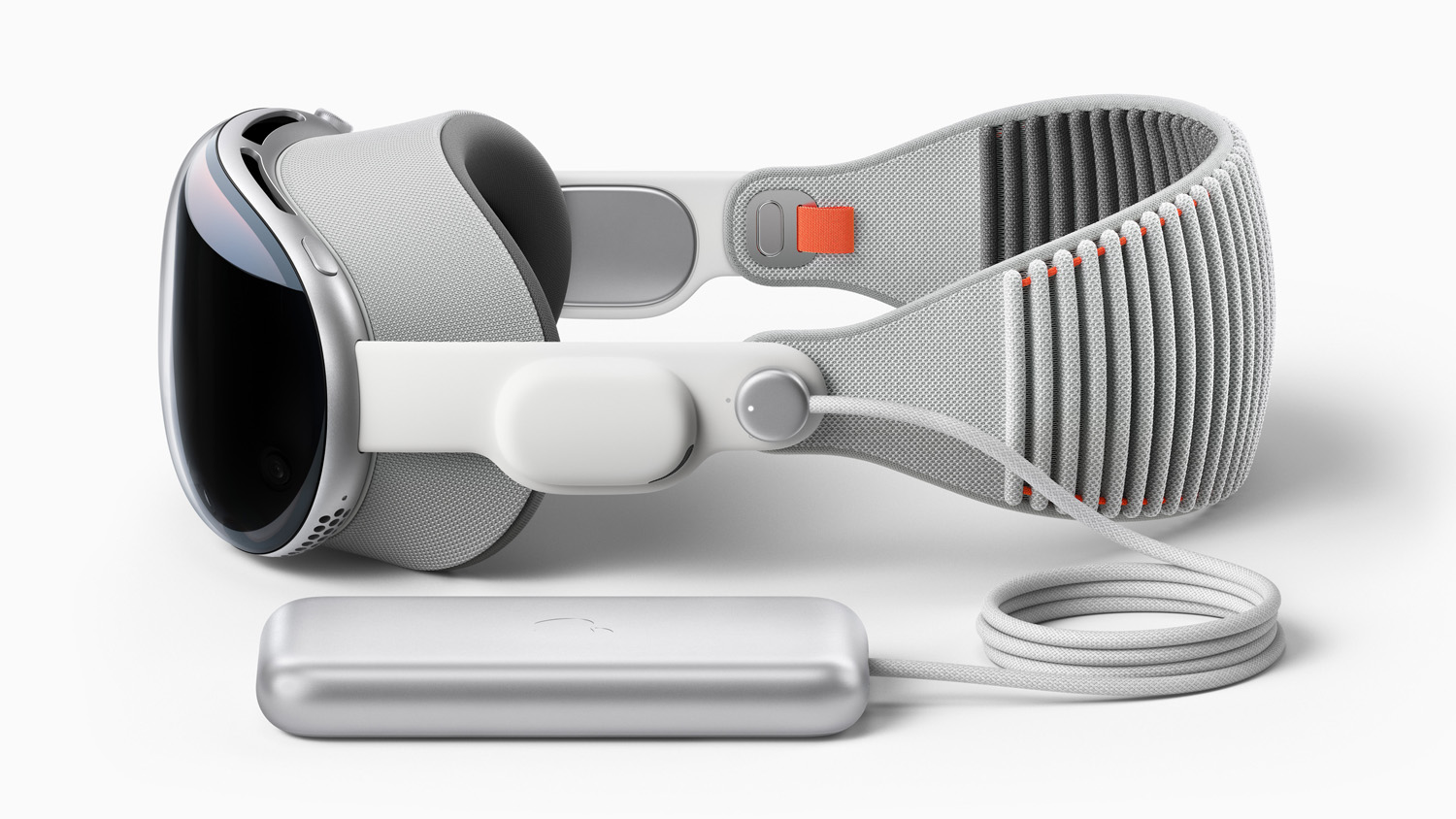


There’s also a dial-adjustable fabric headband which is ribbed and available in multiple sizes. As I mentioned earlier, if you wear prescription lenses you can buy them to fit inside the headset, made in collaboration with Zeiss.
There’s an Apple Watch or AirPods Max style Digital Crown, alongside a pressable button for features such as photo taking. You can use the crown to focus on content to ensure full clarity.
The spatial audio setup is provided by audio buds that sit on your ears – you can see them in the image below.
One of the major talking points is the 3166mAh battery pack, which is waist-mounted. This keeps the headset weight down (though it is still heavy) but it has been downplayed in most official pictures. It may not be a great look but it is, of course, wholly necessary. You can also use the device plugged into the mains, should you prefer, and I believe many users will acquire longer cables to do just this.
It is connected to the headset via a MagSafe cable that you can also see in this pic, so it will disconnect if it gets caught up just like a MacBook charger.
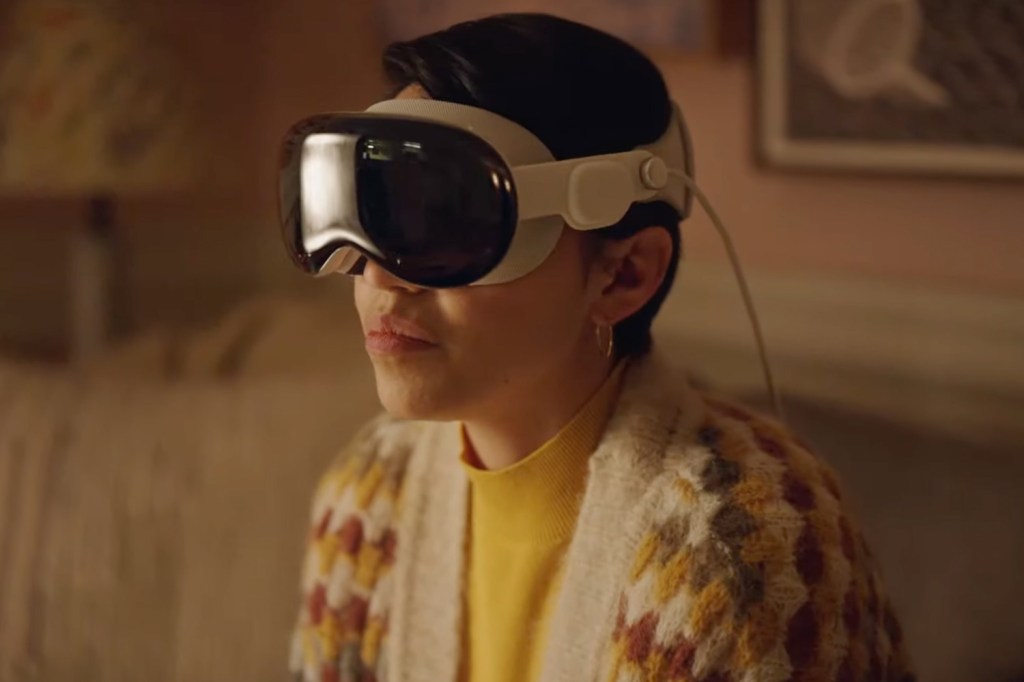
Apple Vision Pro specs
The Vision Pro headset boasts state-of-the-art hardware inside. It really is quite incredible what Apple has packed in here though, as you’ve already read, it has come at a high price. Firstly, there are two 4K micro OLED panels (each the size of a postage stamp) boasting 23 million pixels.
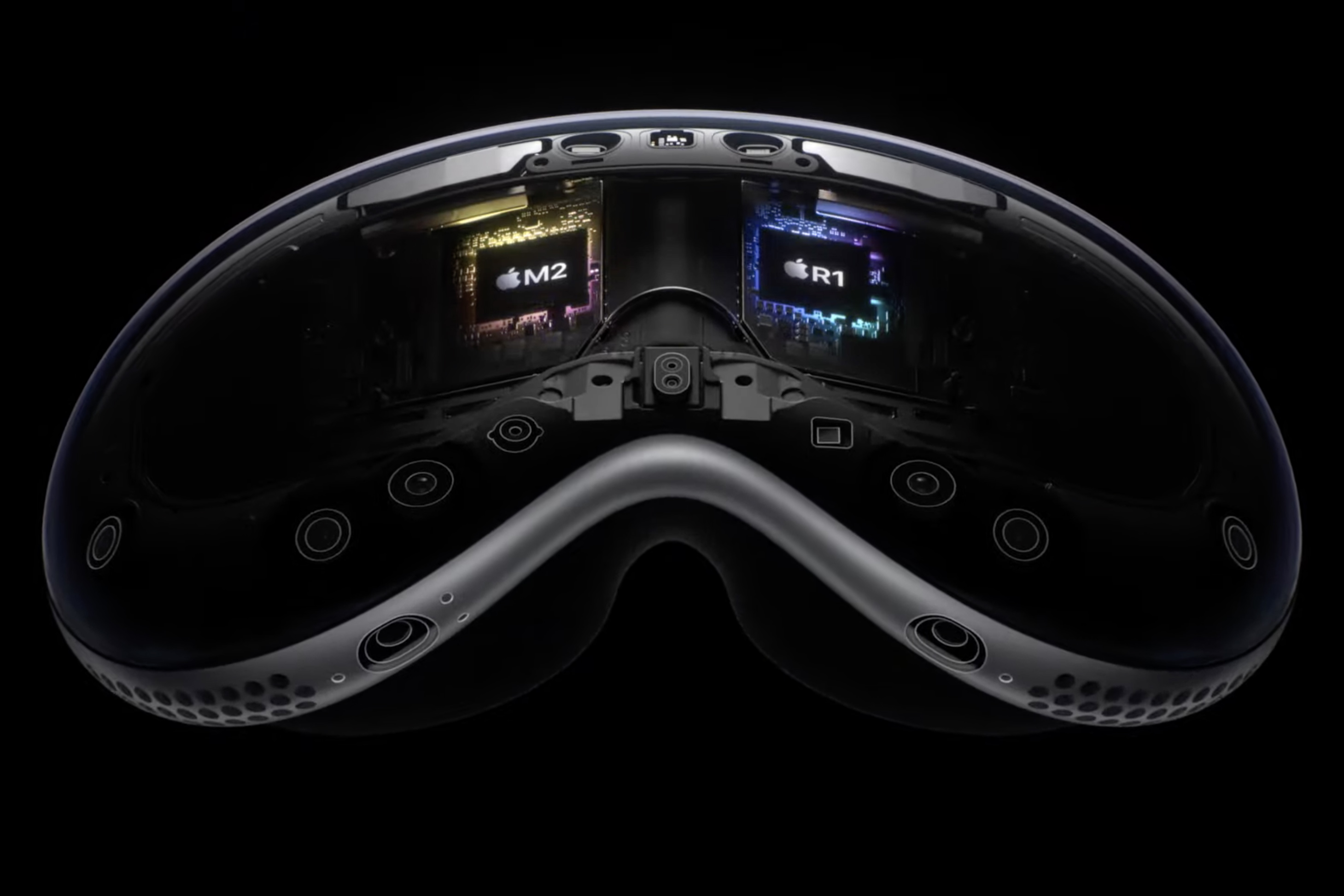
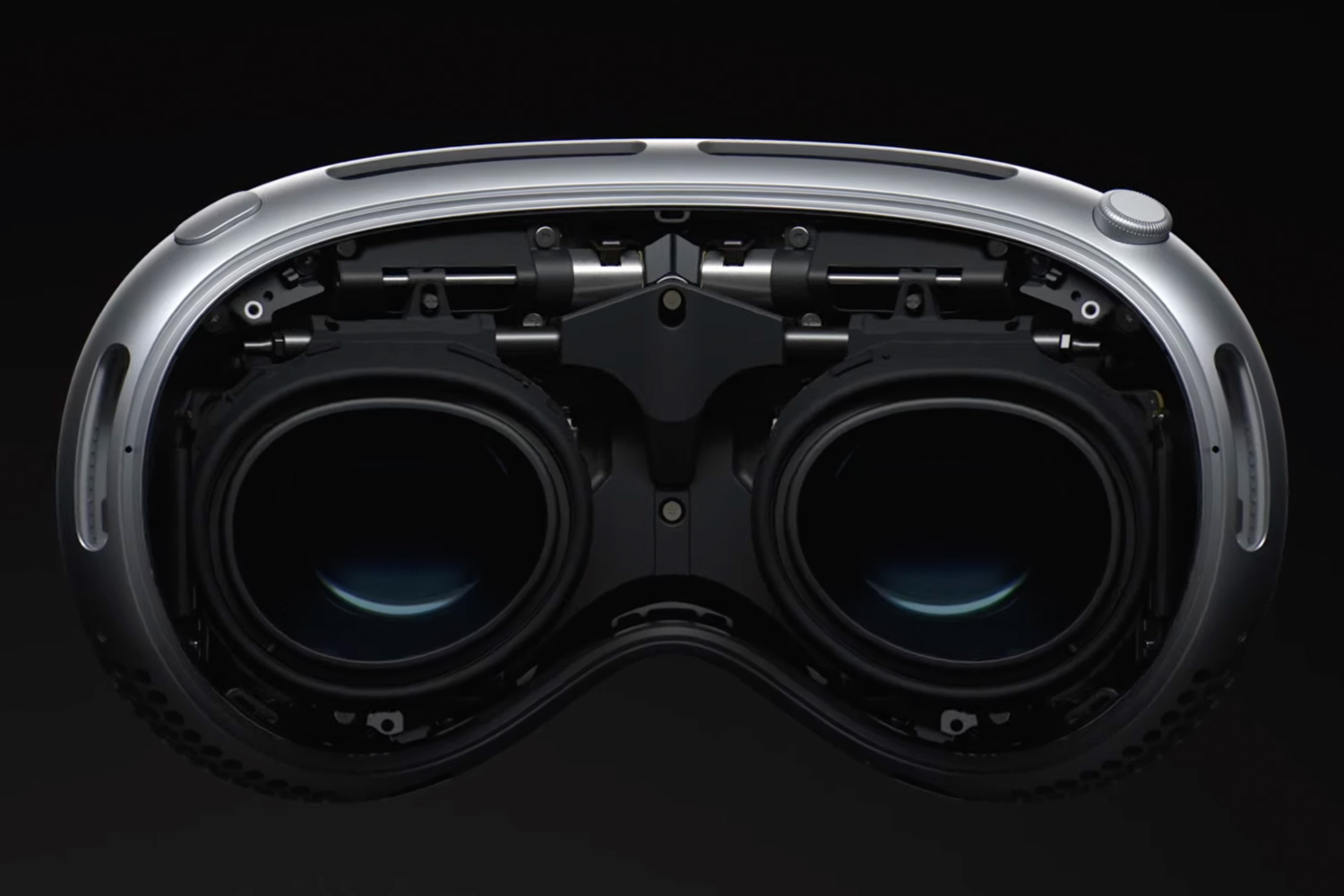
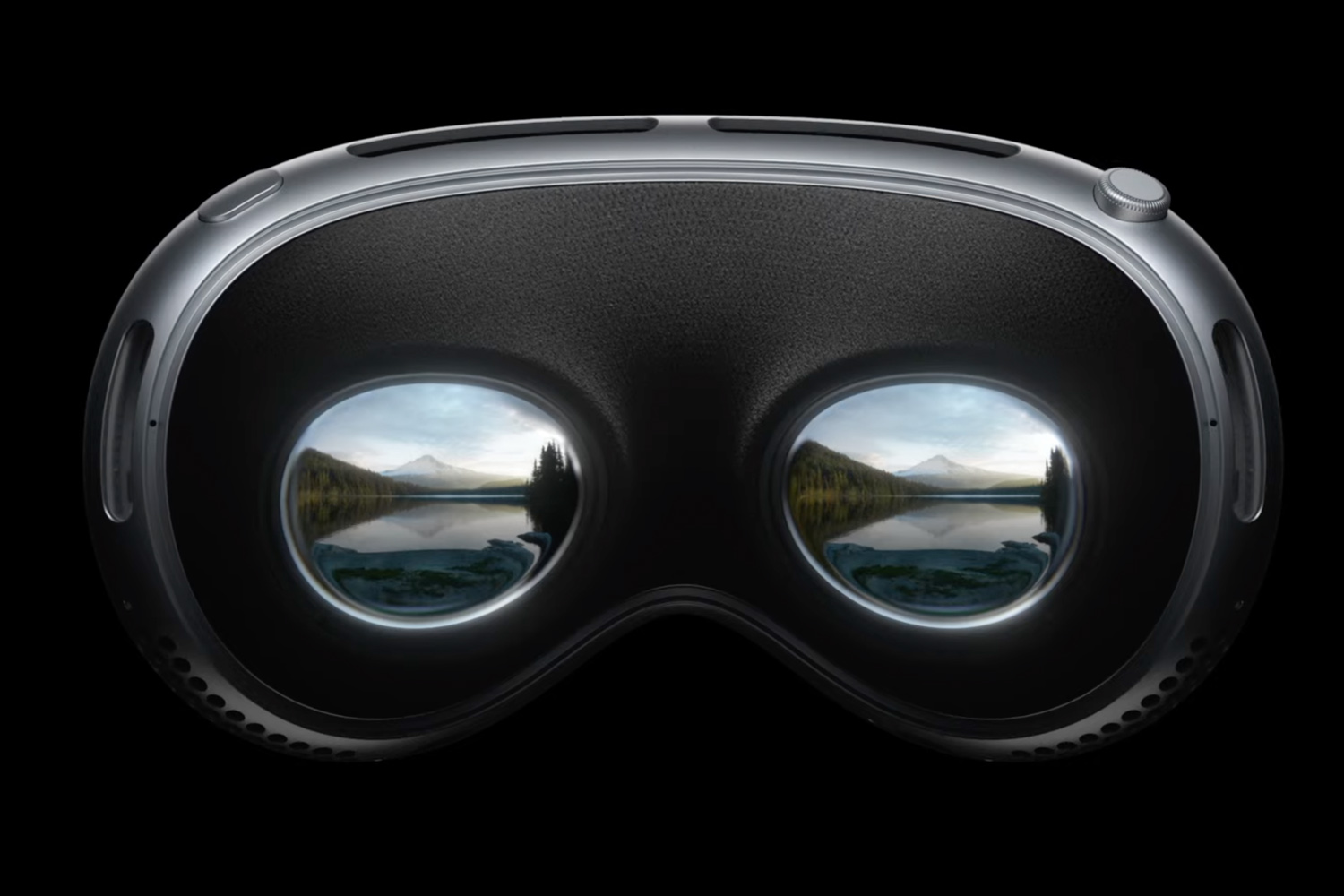
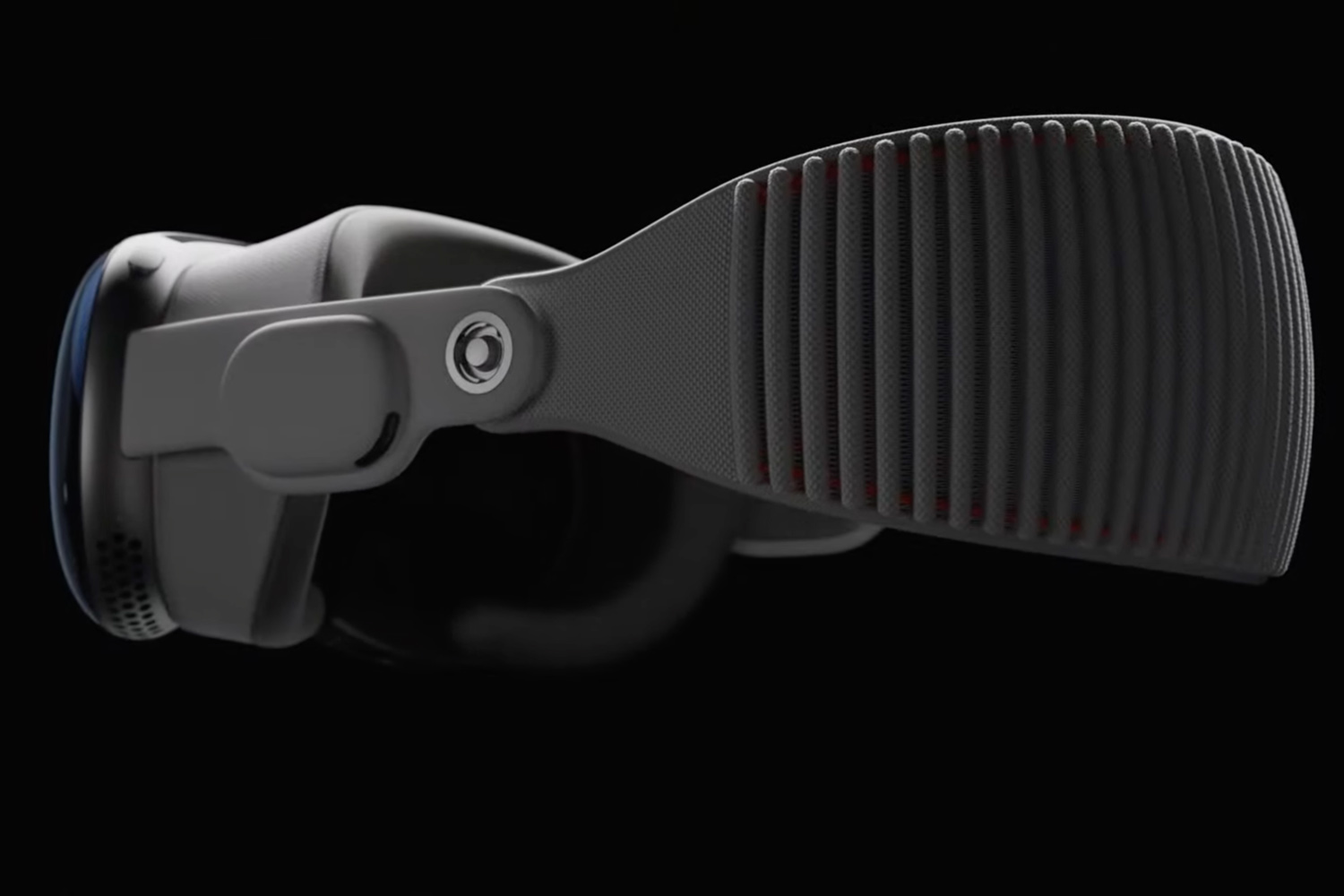

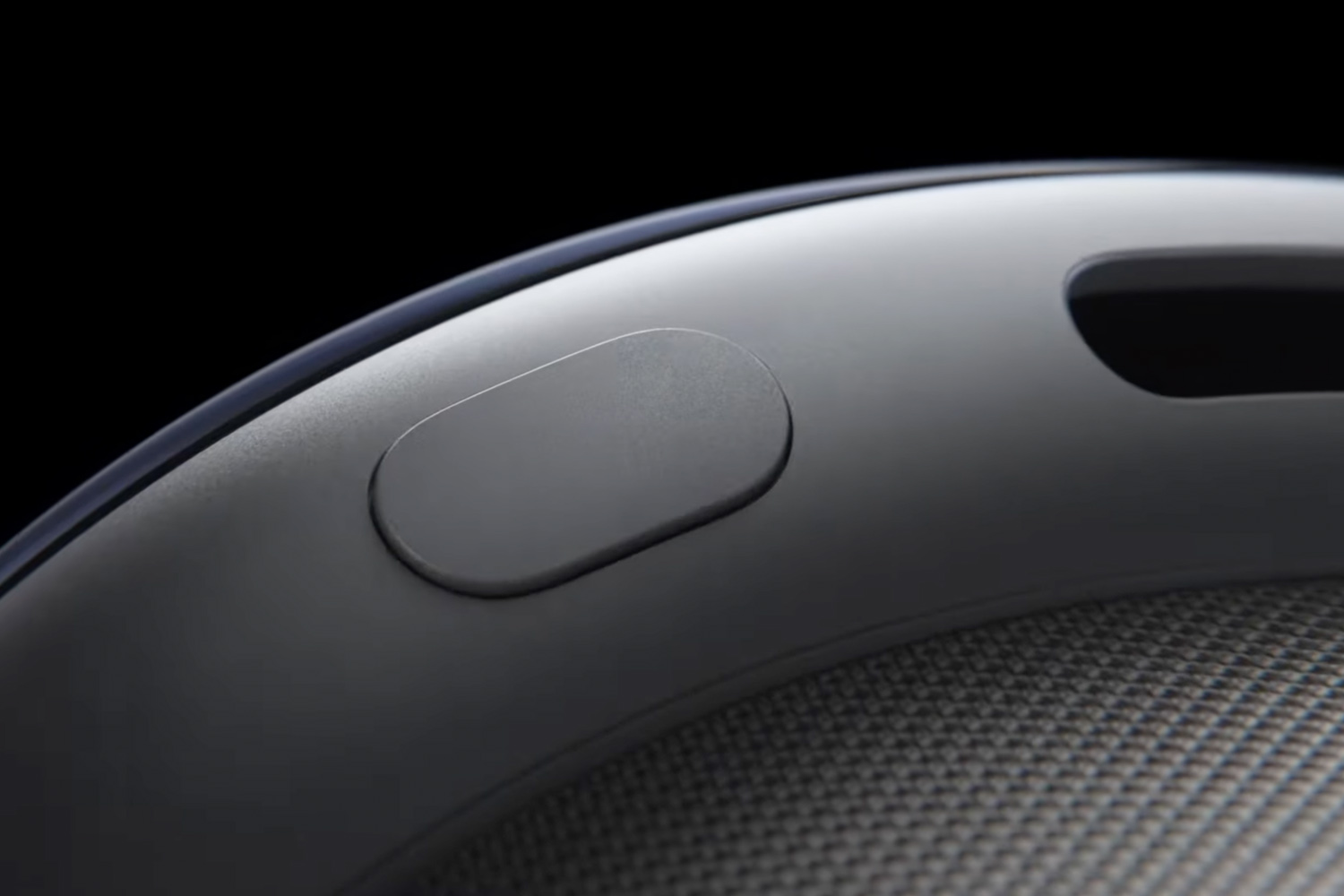
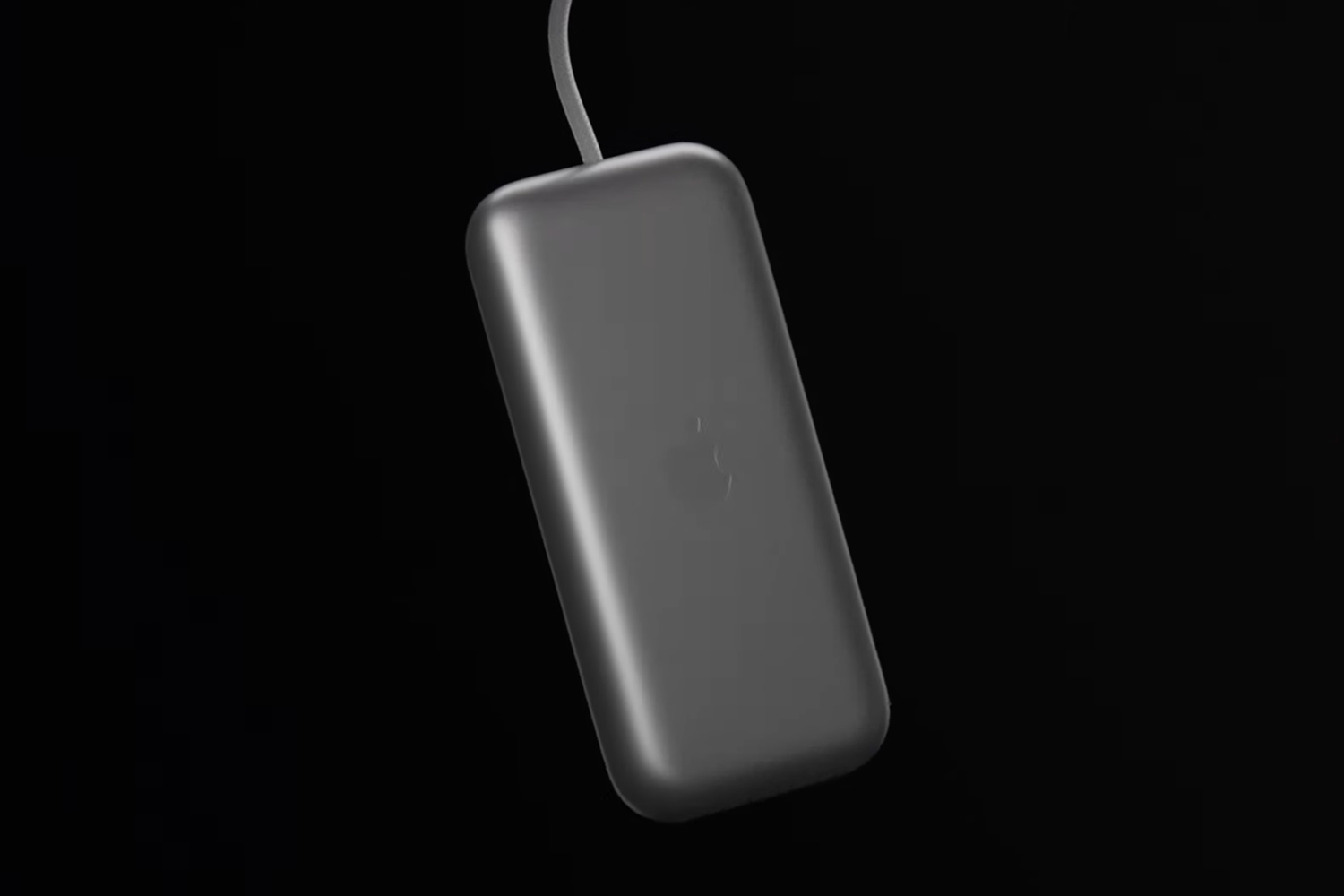
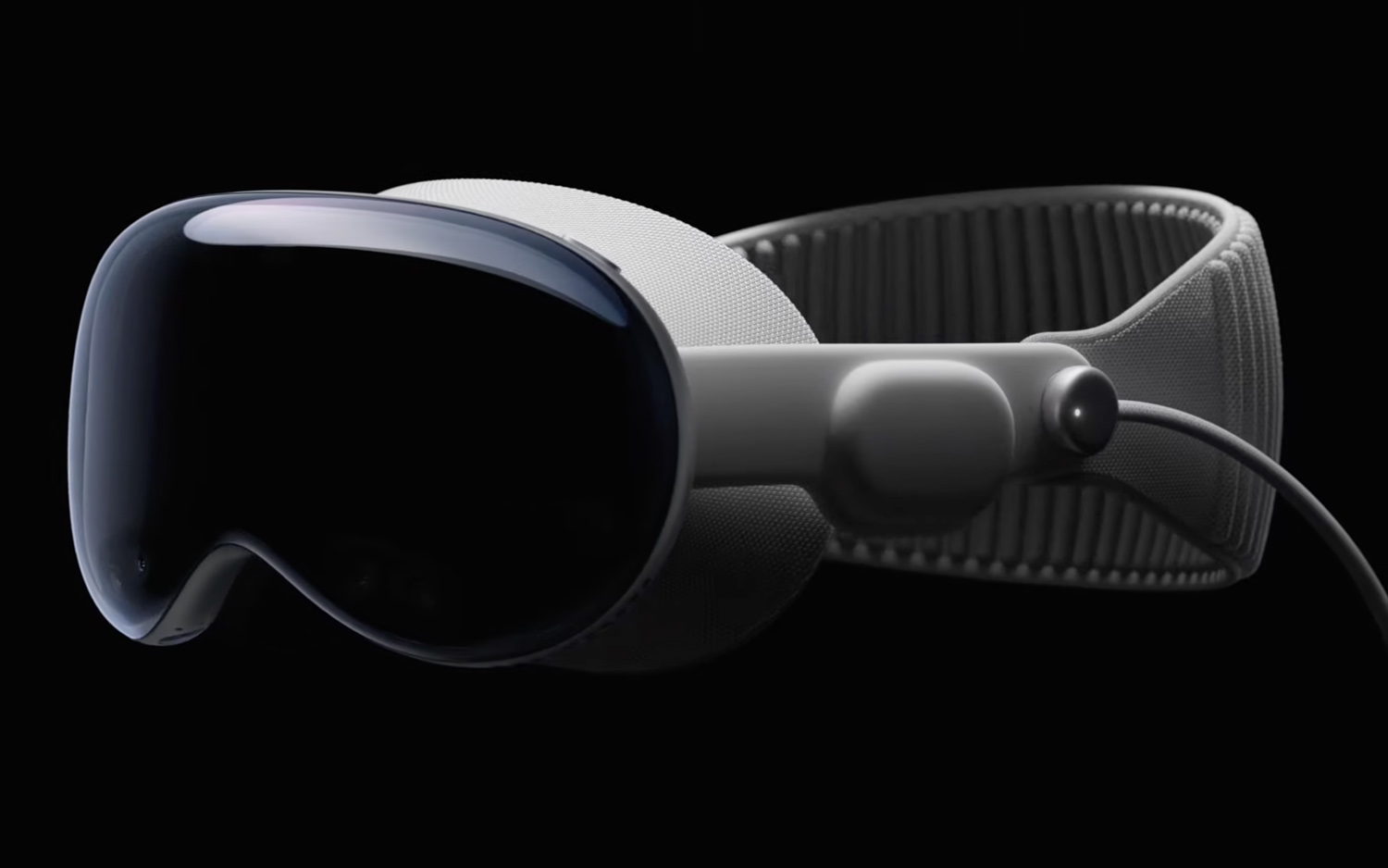
There are a whopping 12 cameras plus five sensors on board (including LiDAR and IR), and six microphones underneath. Two Apple Silicon chips are used; the M2 and a new R1 chip – the latter is dedicated to processing input from all the cameras and sensors. Apple says that R1 streams images to the displays within 12 milliseconds which is eight times faster than the blink of an eye. Incredibly capable hardware, then.
As we mentioned earlier, Vision Pro boasts Spatial Audio just like the AirPods Pro 2. Apple claims this will match sound to the size and shape of the room you’re in, although we’re not quite sure how that will work in practice.
visionOS software and features

The Vision Pro headset runs visionOS – a new operating system built on iOS, Apps can support real-time rendering but the software is clever enough to only render the graphics you’re actually looking at, which obviously saves on processing effort and presumably has an effect on power efficiency.
Here’s s Apple’s latest Vision Pro ad which gives you a bit more insight into the OS.
Apple says that the 3D interface in visionOS frees apps “from the boundaries of a display so they can appear side by side at any scale.” And that certainly looks to be true.
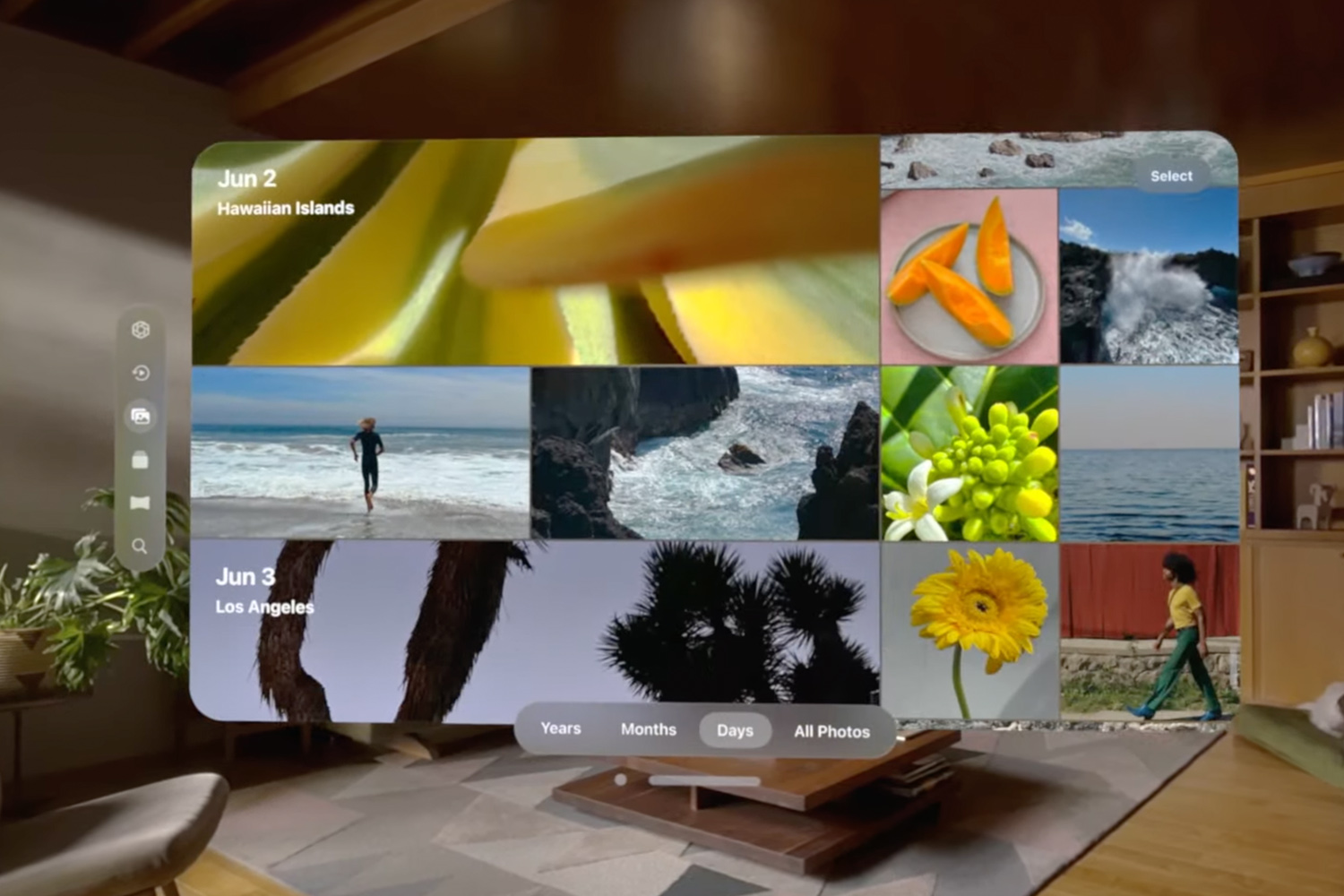
You can control everything with a few gestures while apps respond to where you move your eyes. Here’s a guided tour of Apple Vision Pro that explains how the gestures work in detail.
Vision Pro home screen
There’s a honeycomb-style home view just like on Apple Watch. Apple says it has taken care to ensure that the different elements have depth to them so that it looks like they’re in the room with you. You can place apps anywhere you like and scale them up or down.
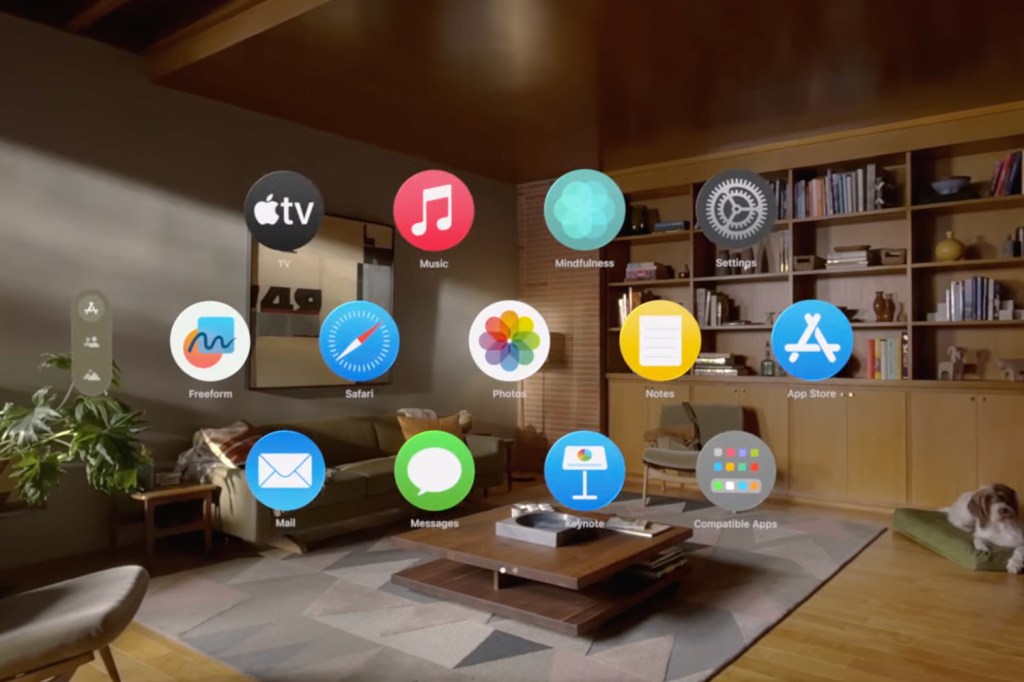
One interesting fact is that you can’t customise the home screen. The main app page includes Apple’s own apps as you can see – TV, Music, Mindfulness, Settings, Freeform, Safari, Photos, Notes, App Store, Mail, Messages, and Keynote. There is also a Compatible Apps folder, which reports suggest isn’t user-curated and includes any iPad apps you might have downloaded that aren’t native to Vision Pro. There are then other app pages for other downloaded apps as you’d expect. A swipe of the hand helps you move through the pages but you can’t (at this stage) move apps around or create folders.
Other capabilities
Siri also works fully, so you can ask it to do various tasks or open apps as well as fill things like text boxes – we’re guessing that voice control will have quite a big role to play with Vision Pro.
Vision Pro’s whackiest software feature is called EyeSight. The jury’s out on this one – is it a bit freaky? It shows your eyes when other people are nearby – and those people will also appear in your virtual view too.
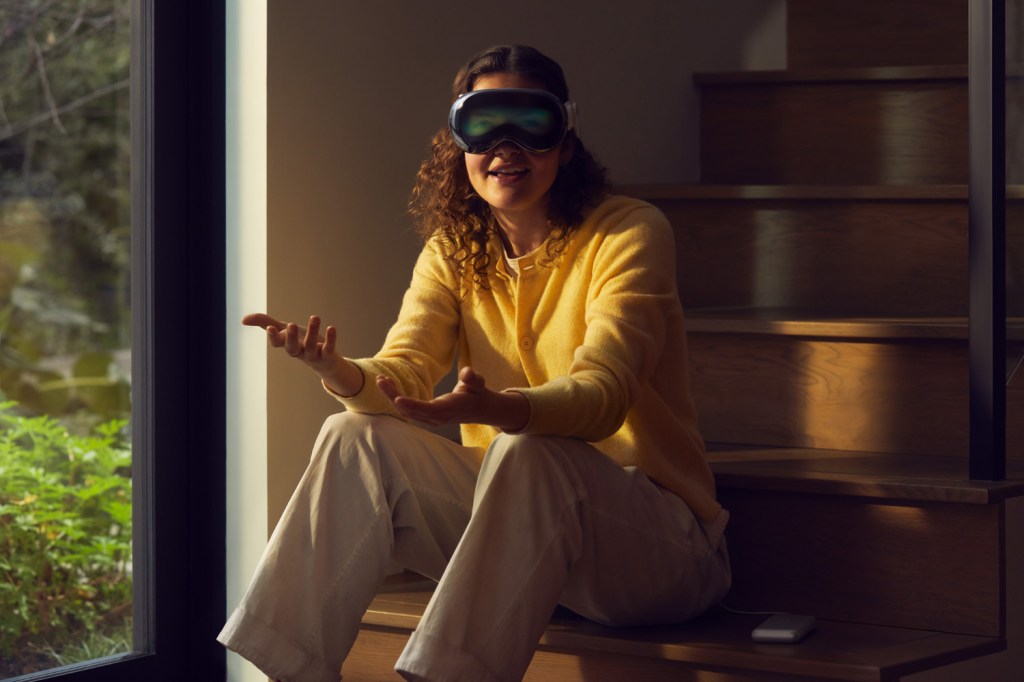
Vision Pro will also work alongside the Mac, essentially as an extra 4K display for it – and you can use it with accessories such as the Magic Trackpad should you wish.
The headset uses Optic ID – iris scanning – for security and to unlock Vision Pro. You’ll be able to use it with Apple Pay and other features just like Face ID. Just like your iPhone, that information is stored on the headset and Apple says it won’t track things like your eye movements. Info from the sensors and cameras is also processed on board.
Photos and videos can also be viewed at a life-size scale. Panorama shots from iPhone expand and wrap around you.
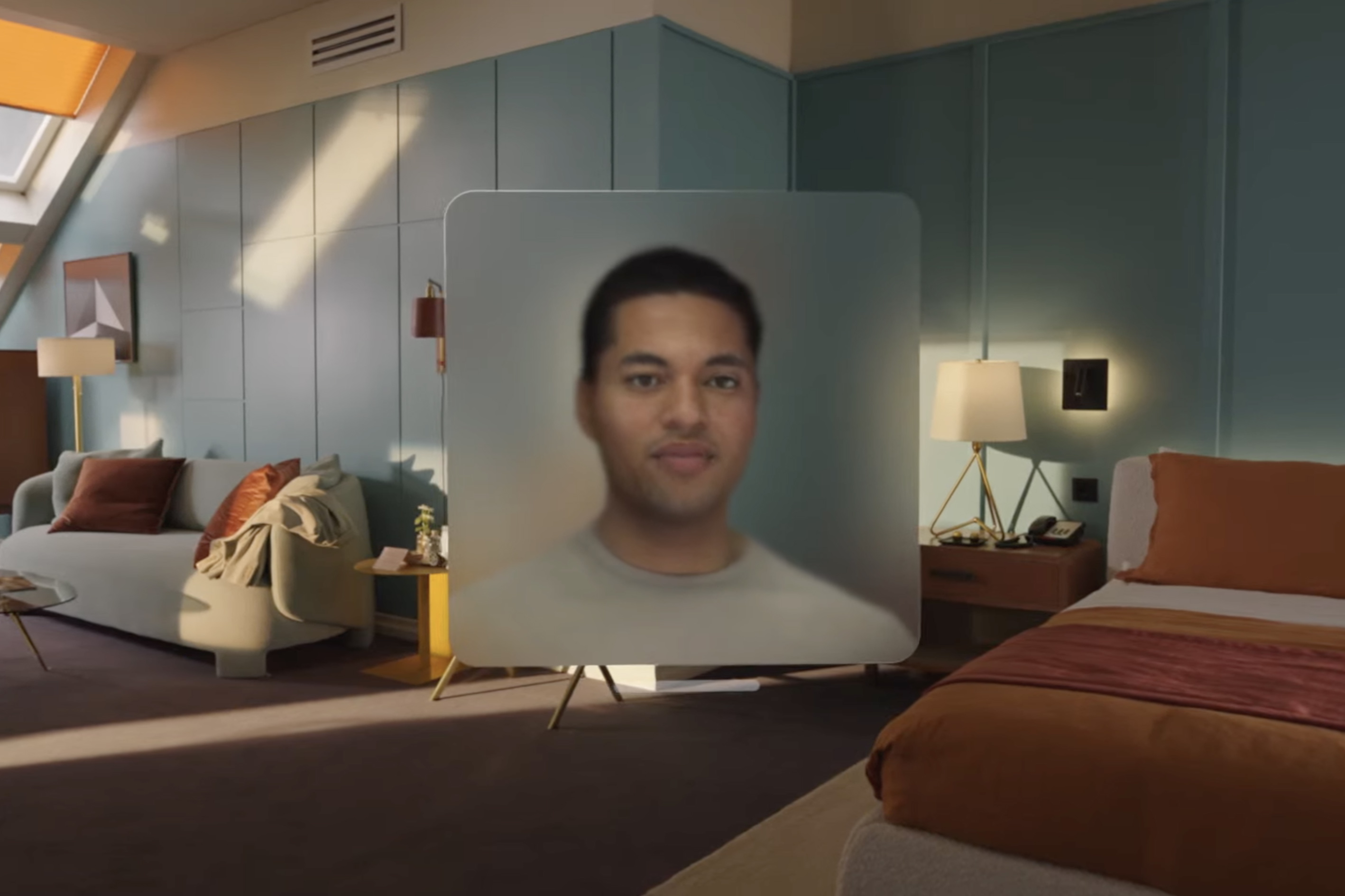

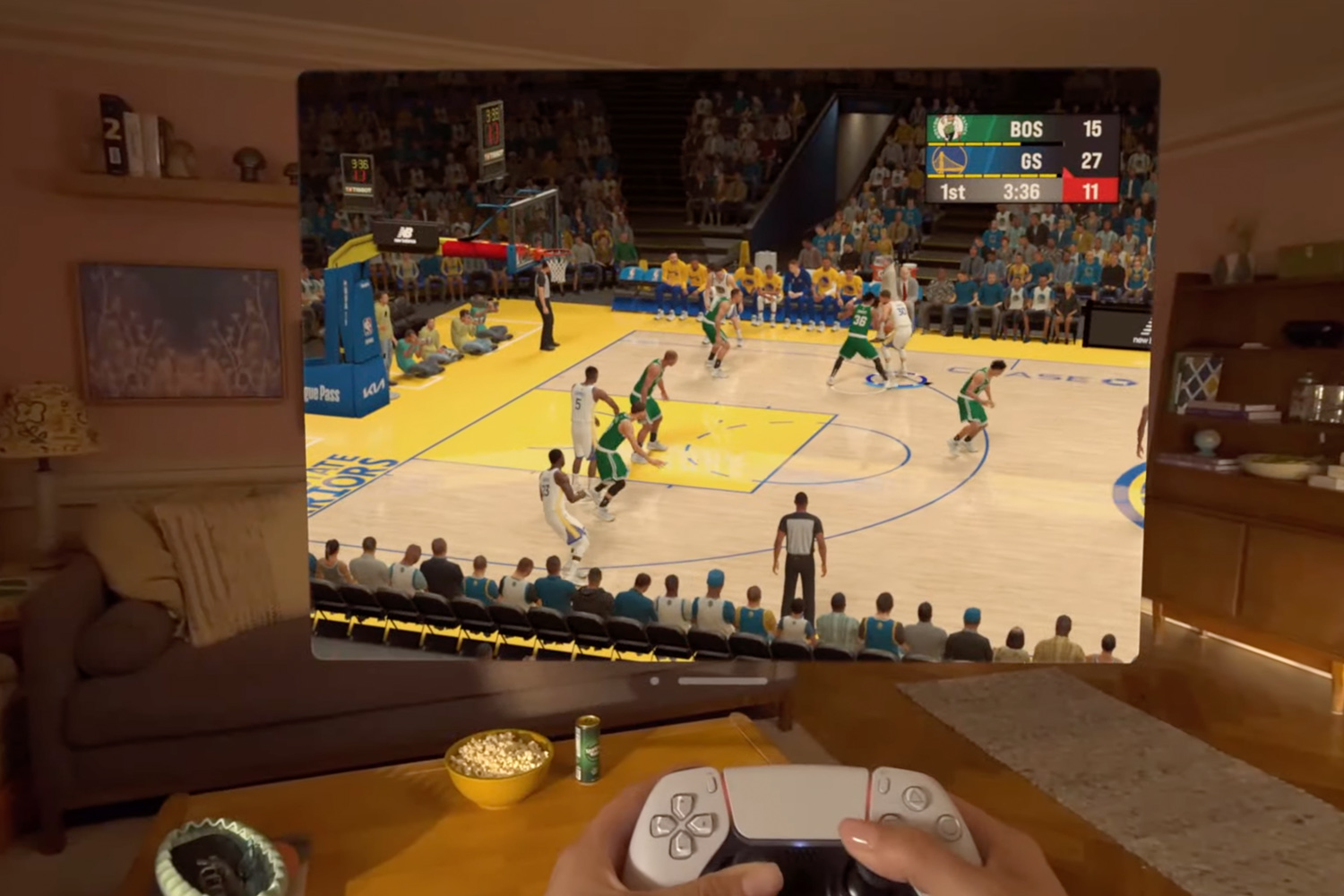
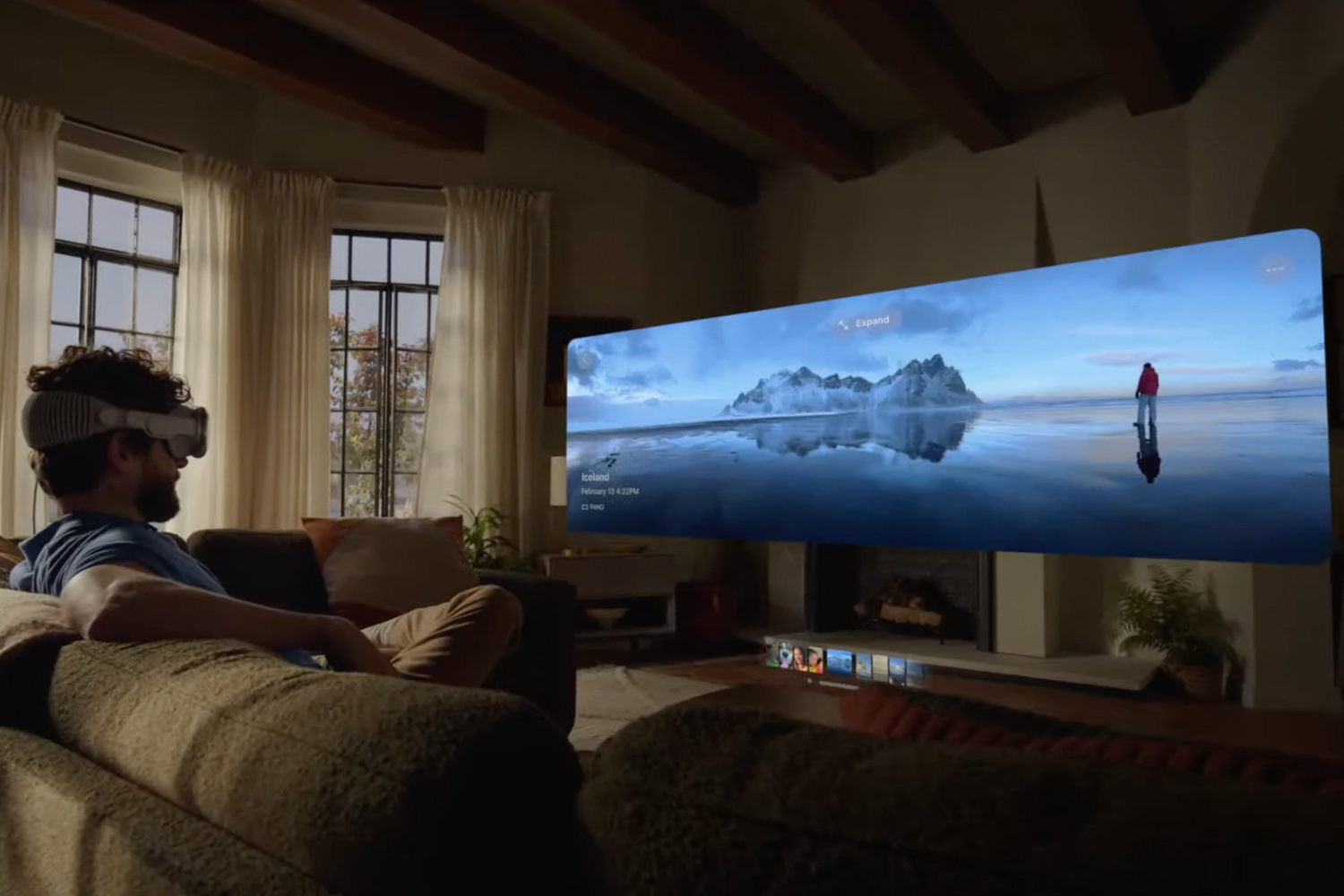
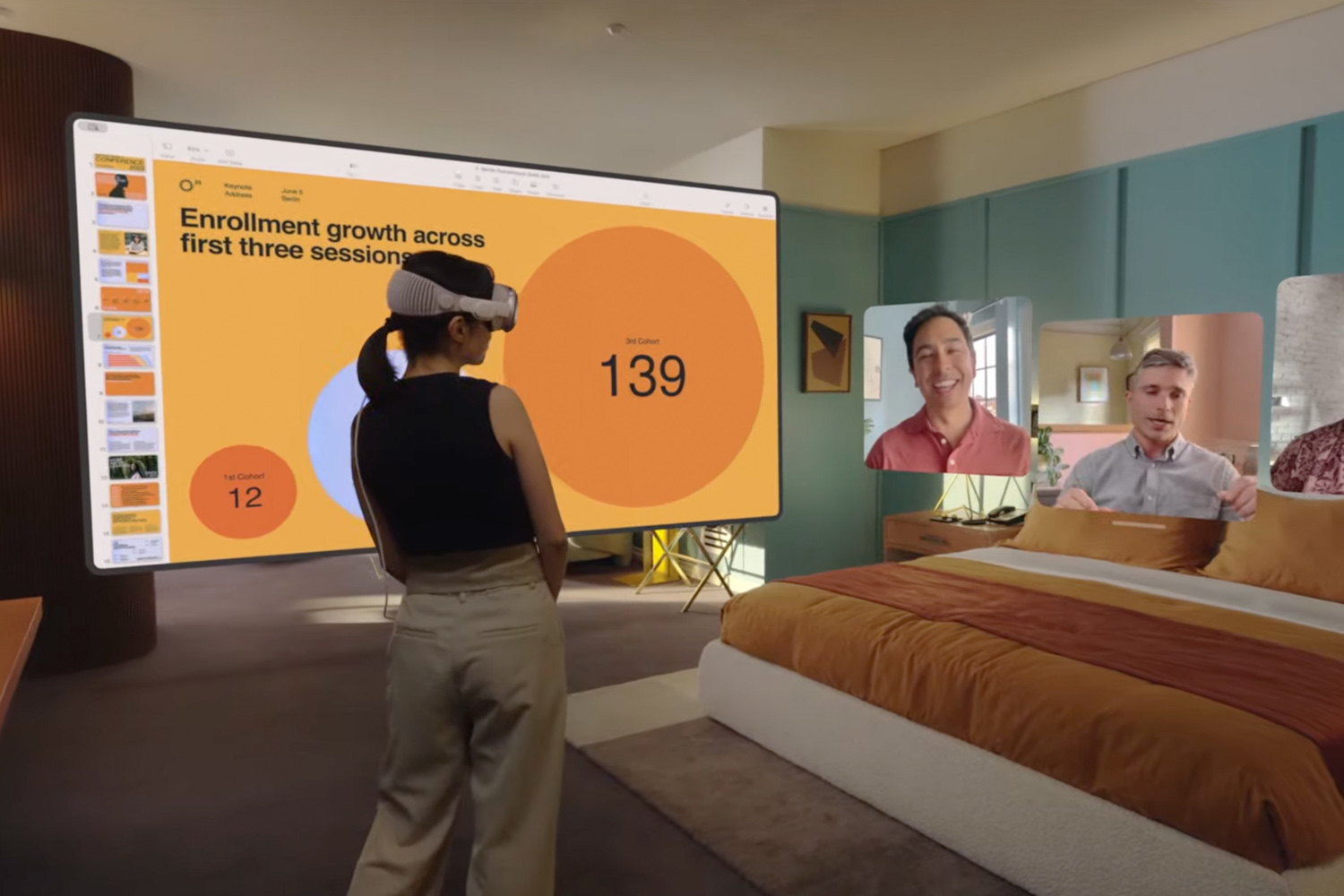
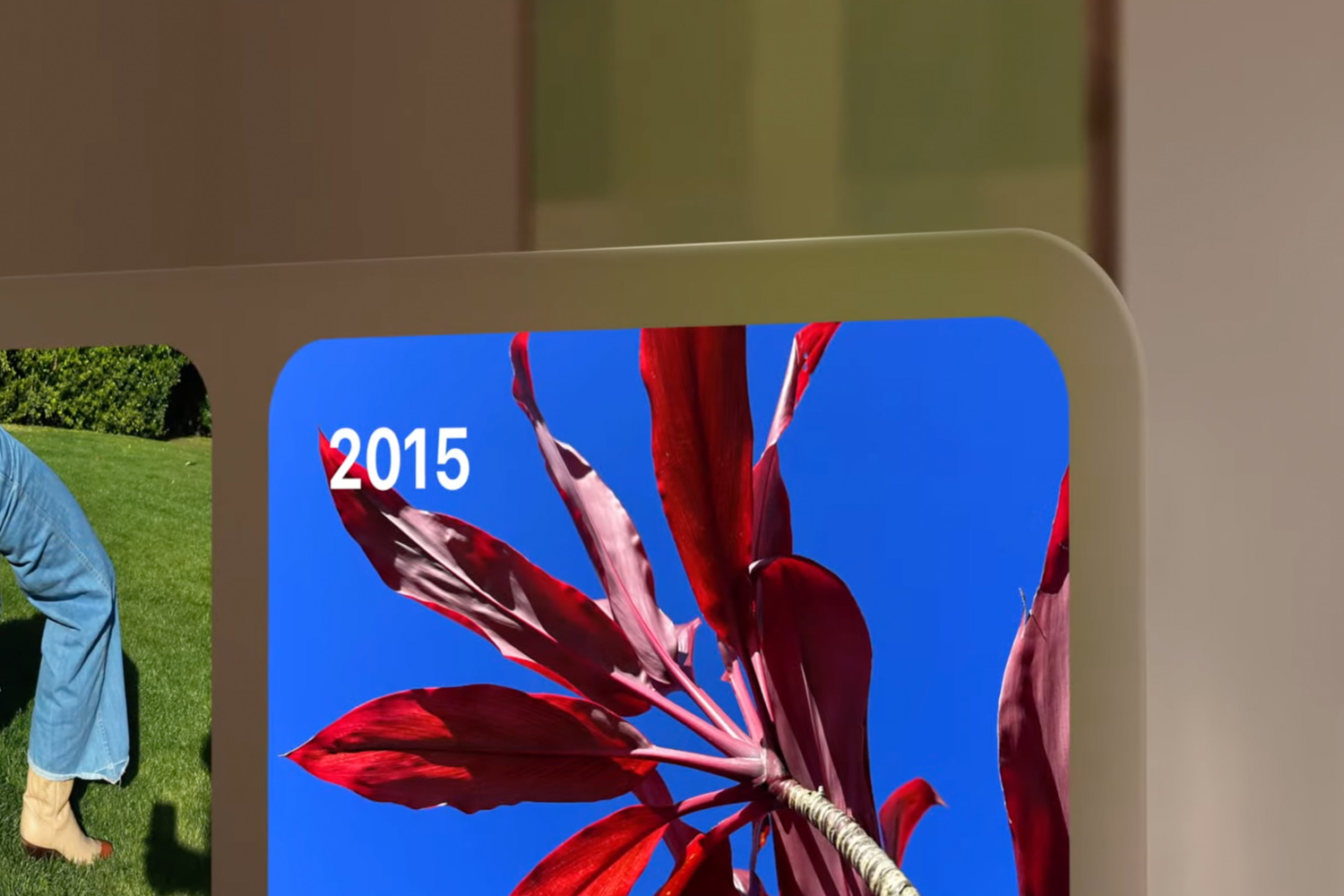
So what apps are available?
Apple’s own apps will work well, including FaceTime and Messages as well as Safari, though of course, Apple wants developers on board who will design new apps to support gesture controls and take advantage of the headset’s capabilities. And they are arriving in spades – many have already been converted for the platform and it seems the store will have around 230 native Vision Pro apps at launch.
We know that productivity apps including Microsoft 365, Zoom and Slack are arriving as well as Disney+, Prime Video, Peacopck, Discovery+ and Max for entertainment. Netflix and YouTube aren’t coming for now, but you can stream via those services in Safari.
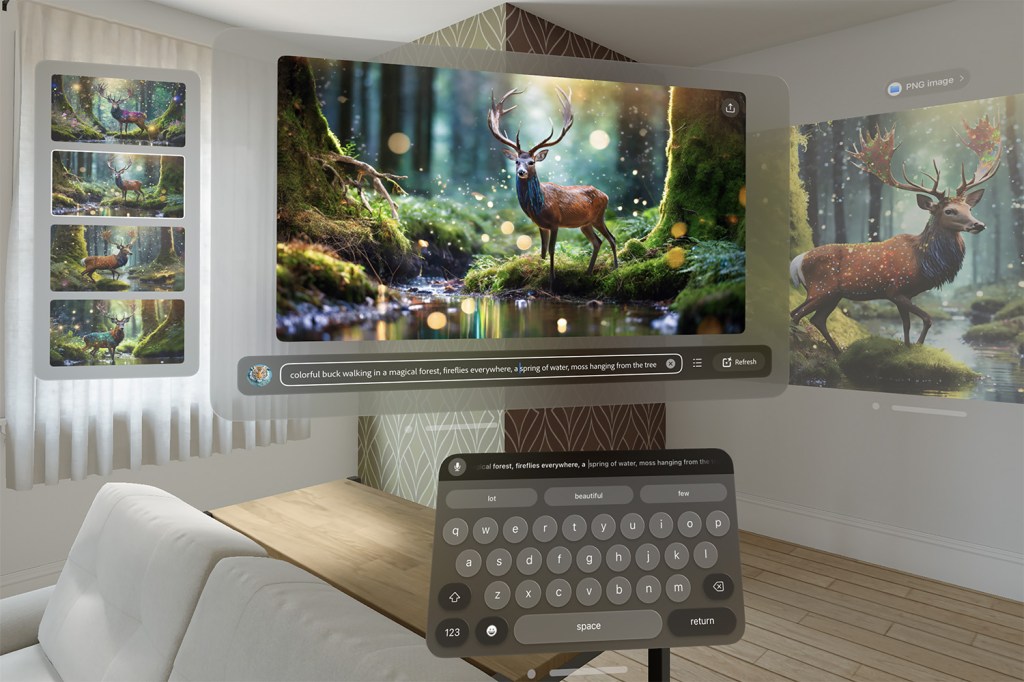
Adobe has announced support for the headset, with text to image capabilities in the AI-based Adobe Firefly. In the future, it says work will incorporate generating wrap-around panoramas, 360-degree environments and more. Adobe Lightroom support is also available, as is Adobe Fresco.
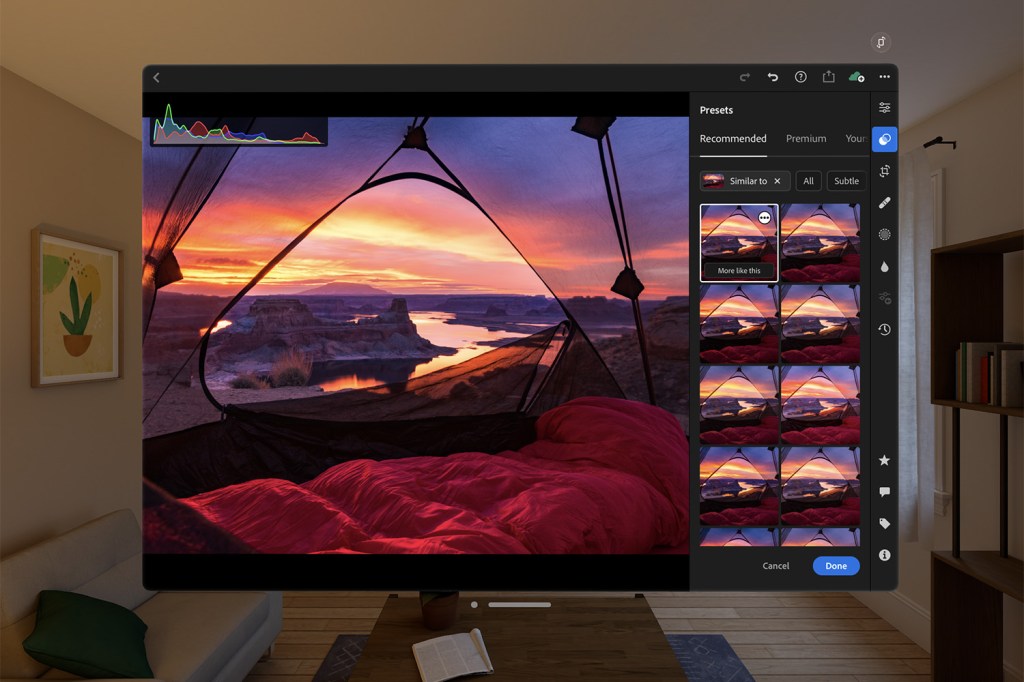
So what do the Apple apps offer? In Messages, you can send 3D objects while SharePlay enables you to watch content together. FaceTime calls take advantage of your room around the user, with everyone in life-size tiles. Spatial Audio is also used, so it sounds as if participants are speaking from where they are.
If you wear Vision Pro during a FaceTime call you are reflected as a Persona — a digital representation of yourself created which reflects face and hand movements in real time. Some early reviews of the headset have branded this as uncanny and we’ll have to wait and see how this is received further.
As you might expect, Apple TV+ works with Vision Pro while Disney is also on board – it’s been announced that Disney+ will work with it, too and there’s additional interactivity.
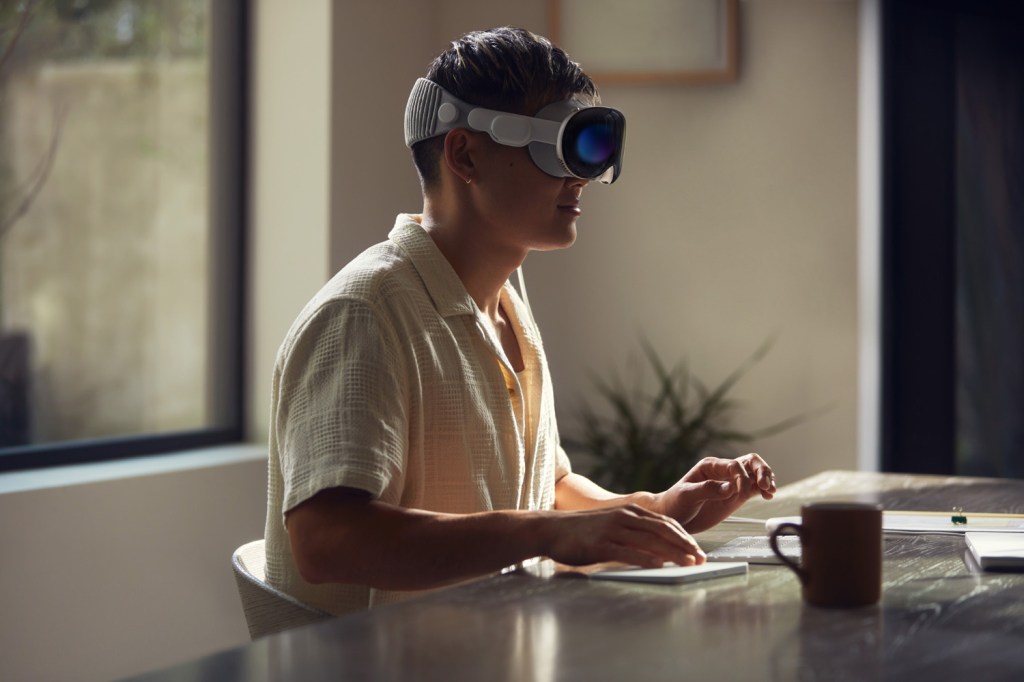
Unity-based games and apps will also make their way to the headset and there will also be a new App Store, where you can discover visionOS apps as well as download iOS and iPadOS apps (we’re not currently sure how you would use them though). Over 100 Apple Arcade games are also available to natively play at launch.
Certainly Apple Vision Pro offers a huge amount, but you will pay a lot for it. Only time will tell whether Apple has judged it right.
